Discourse II
March 18, 2012, 2:30 pm
Prologue in the context of the Tourism Day of the Saarbrücken Region 2012
Courage to do less, fullness of being - explorations about sustainability
Reading, talk, meditative walk with Ulrich Grober and Peter Michael Lupp
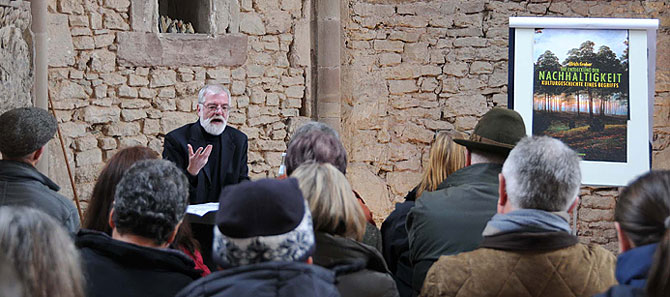
Follow up to the event
Impressions and reflections by Ulrich Grober
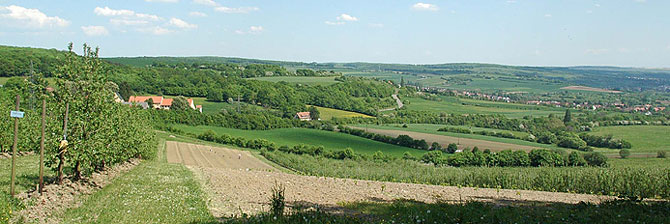
There was something liberating about it: Turning out of the valley of the Saar, which is narrowed here by settlement structures and traffic routes as if by a straitjacket, and changing to the country road shortly before Kleinblittersdorf. As the road climbs gently, an overwhelmingly wide, tranquil landscape opens up before our eyes. Bright hills, a mosaic of fields and bodies of water, meadows, orchards and forests, wandering clouds, horizons that cross borders, villages and farming communities - the Bliesgau. The "panoramic" feeling can be addictive. A dirt road branches off from the road, winds uphill, and disappears into the forest interior. I can hardly escape its pull. Should I suggest to Liz and Jörn Wallacher, with whom I'm traveling on this Sunday afternoon, to leave the car, get out and then: just go? But we have already reached our destination, the Wintringer farm.
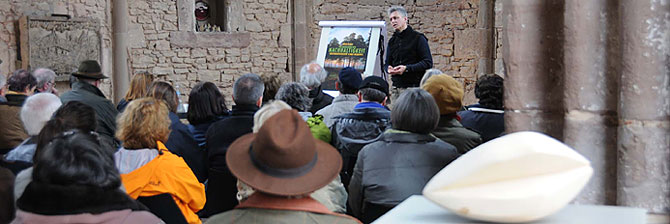
The farm, says Peter Michael Lupp in greeting, forms the "gateway", so to speak, to the Bliesgau Biosphere Reserve. It consists of two pillars. A community - with some disabled people - operates organic farming here on a large area and quite successfully. In the midst of the farmstead rises a relic from the Middle Ages. It is an exquisite piece of late Gothic architecture, carefully restored, the remains of a former priory church. Today it serves as a "cultural site". As a space and free space of care for the immaterial needs: To come to rest, to open up new spiritual perspectives in the dialogue with oneself and with others, to define common values and goals. It is cultural sites - places of thought - places of learning like this that create lasting cohesion in communities and regions. We need them more urgently than ever. The new purpose of this chapel is basically a return to the roots. This building was built in the autumn of the Middle Ages, a time of multiple crises - plague, hardship, apocalyptic fears and hunger for spirituality.
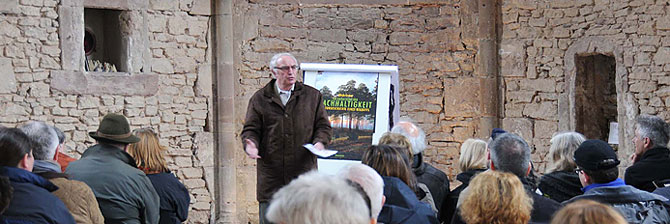
Manfred Zimmer, 1st chairman of Lebenshilfe für Menschen mit Behinderungen e.V., emphasized that the Wintringer farm has already been managed according to the guidelines of organic farming for 25 years and, as a showcase farm for organic farming, provides important impetus for sustainable development in the Saarbrücken region.
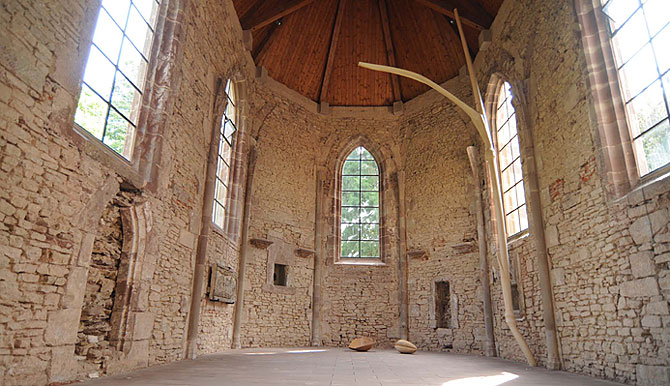
Immediate eye-catcher when entering the interior is a wooden sculpture. It towers nine meters above the ground, abutting the vaulted ceiling. Carved from a maple trunk, it represents a stalk of grain that has broken through the stone floor, grown oversized, and snapped at the ceiling. A pointed leaf has broken away from the stalk. A lone grain - grown grotesquely large - has fallen to the ground and lies separated from the chaff. Hermann Bigelmayr - "The Limits to Growth." The artwork was created for this space. Its title alludes to the Club of Rome report that became famous. This report was an early warning about the risks of the exponential growth of our industrial society. On 12. March 1972, almost forty years ago to the day, the report was presented to the world public - and set in motion worldwide the discourse on sustainability and a search movement based on it.
The room fills with visitors: young, old, people from the farm, veteran foresters, a young sinologist, an architect and activist, a dedicated educator, a guest from Poland - just a cross-section of my encounters over the course of this afternoon. My introduction to today's "Discourse on the Exhibition" is a Goethe word: "...baked bread is tasty and filling - for one day; but flour cannot be sown, and the seeds should not be ground." A wonderful allegory for sustainability. Everyone understands it, even more so here, in the agricultural ambience of the Wintringer farm. Goethe by no means disdains daily satiety, enjoyment, the aroma of freshly baked bread, self-care. But, he says, self-care includes care for the seed, that is, provision. And with that he brings into play the conditions for the seeds to grow and thrive: soil fertility, water balance, biodiversity, in a word - ecology.
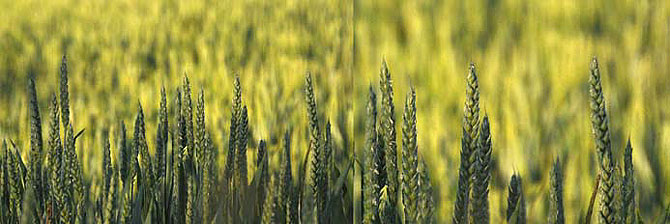
Nature does not know limitless growth. Only germination, growth, maturation and decay. The skill - and wisdom - of the farmer and forester is to harvest at the moment of peak maturity. And at the same time to provide for "natural regeneration", regeneration. The idea of permanent growth of structures springs from human hubris. This logic leads inevitably to... collapse. This was the message of the Club of Rome forty years ago and is the statement of Hermann Bigelmayr's sculpture here and today.
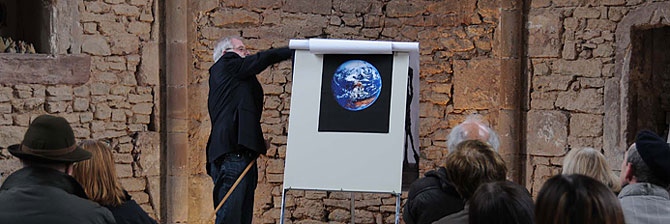
A second entry, this time about a picture, an icon of our epoch: "Blue marble", the photo of the Earth, taken from a distance of 45,000 kilometers by the crew of the Apollo 11 spacecraft in December 1972, a few months after the publication of "Limits to Growth". Three key words are essential for the contemporary interpretation of this grandiose image: when mankind saw the blue planet from the outside for the first time in its history, it marveled at its beauty, its uniqueness, its fragility. But what makes it so beautiful, so unique? What is so fragile about it? It is this "pattern of clouds, oceans, green land and soils" (Brundtland Report), this gossamer, delicate layer that supports all life - the biosphere. The declaration of love for the blue planet and respect for the tiny slice of biosphere on our doorstep are complementary.
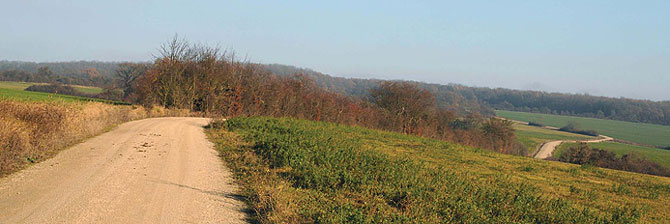
Sudden flash of inspiration, here at this location in the Bliesgau Biosphere Reserve: To gradually transform the entire earth into a biosphere reserve - that would be genuinely sustainable, wouldn't it? The 553 reserves worldwide today are only a beginning, pioneer plants, so to speak, but as such infinitely precious.
As we step outside, a gentle spring rain has begun. Nevertheless, most of the visitors set off together. The route, chosen by Peter Michael Lupp, leads along a section of a rediscovered pilgrimage trail. A look back. From the path, you can see how far the farm complex extends with its stables, workshops, with the greenhouse and the farm store. A small piece of common good economy in an ancient cultural landscape. Then we are in the forest. Ascent to the Kappelberg. The earth smells fresh. Wood anemones, snowdrops and other early bloomers are already in bloom. The wild garlic is there. The buds on the beeches and oaks are plump. Even now in the afternoon a many-voiced bird concert can be heard. Blackcap and chaffinch, robin and great tit.
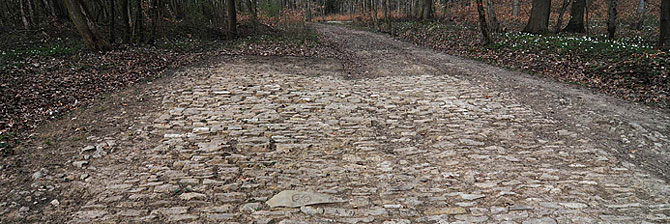
We pause at an exposed piece of road paved with field stones. A remnant of a sunken medieval piece of road construction, perhaps even from Roman times, explains Peter Michael Lupp.
Pilgrims of St. James also passed through here under the protection of merchant trains on their way to Santiago de Compostela. Only recently have the stones in the ground been rediscovered. The relics were uncovered in a qualification project with young people in search of perspectives.
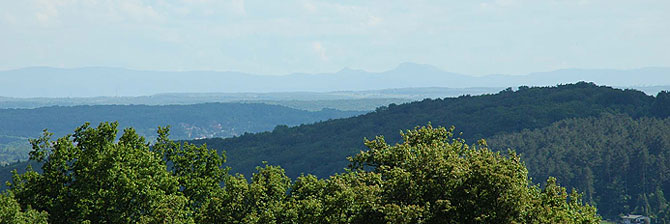
Who walks on the paths through the country, this old borderland between Lorraine and Saarland, feels sooner or later: you are part of a rich history. Then a vantage point. On a clear day, the view from here sweeps as far as the Donon massif of the northern Vosges, on whose slope the Saar rises. We are in the heart of Europe. The combination of intact nature and exquisite culture creates quality of life - isn't this the essence of the "European dream"?
Supplement, March 31, 2012
The FAZ publishes a letter to the editor by Pia Ahrenkilde-Hansen, spokeswoman of the European Commission in Brussels. In the short text, the mantra of the "need for measures to promote growth and employment" appears in every second sentence. Even forty years after the "Limits to Growth," the realization that more growth does not create security but accelerates the path to collapse is still a long way off at this level. The courage to do less will be the basic virtue of a sustainable society. To generate a maximum of quality of life for all from a minimum of resources - that is the great challenge of the 21st century. Is it still understood soon enough?
To read more
Ulrich Grober, The Discovery of Sustainability - Cultural History of a Concept, Antje Kunstmann Verlag, Munich 2010, 298 pages. Price: 19,90 €
